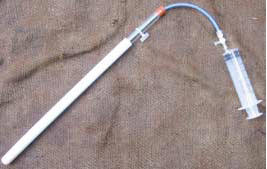|
Monitoring and
managing soil pH
by David Vernon
Grower
Solutions Magazine
Lefroy
Valley Magazine
August
2004
I n the last article I discussed what pH is and the
effect it can have on plant nutrient uptake and the potential for
limiting crop production.
Now some ideas to monitor and manage soil pH
levels. Before any crop is established a soil sample should be
analysed to determine the nutrient levels, soil health, and what may
need to be added to maximize crop yield. For the cost of a few bags of
fertilizer you can establish your soils ability to give you the best
possible outcome - yet this is still not carried out enough.
Historically, adding lime to most horticultural
soils was a standard pre-plant practice. Now, with the higher demands
being placed on our soils productivity and the increasing salinity of
our water sources, the addition of lime to balance the pH may not be
necessary. One of the trends in intensive farming is that our soils
are starting to become more saline, mainly from the residues of
concentrated fertilizers, regular irrigation with increasingly salty
water and infrequent rainfall. Lime or dolomite is used pre-plant to
help bring the soil pH range to the desired level necessary for
maximising crop production. It is also the most cost effective method
for balancing soil pH, but its difficult to know what is required of
your soil without a soil test?
When faced with a soil that is alkaline or neutral
what can be done to keep the pH at the desired level and how do you
monitor it?
You can use one of two simple methods to measure soil
pH during cropping, (both require the use of a quality pH
meter regularly calibrated with standard solutions),
1) taking a soil sample from around the root area, or
2) collect a sample of soil solution from a vacuum tube
placed in the root zone.
Soil samples are accurate but a little more time
consuming. Take a soil sample (preferably air dry it
overnight), mix it with de-ionised water at the rate of 1
part soil to 5 parts water (20g soil:100mls water), mix it
and wait 30 minutes then measure with the pH meter.
With the soil extraction method you will need to install
vacuum tubes in the crop at working root level. The tube
is charged with a vacuum via a syringe at the
commencement of the irrigation cycle and then collected
the following morning from the tube with the same
syringe. The solution collected is then measured with the
pH meter. This is an emerging method for data
collection and is yet to be widely accepted in the general
Agricultural community, however early results are
promising. |
Whatever method you use, it is important to
understand the interaction between your soil and the additives used in
crop production and hence the influence of your soil solution (what
the plant roots actually grow in and absorb).
With high levels of fertilizer and other soil
additives being used in cropping the eventual effects on soil
chemistry can be varied. Most products we add to the soil have an
effect on the soil chemistry, and to understand the changes that
occur! The only way is to monitor.

Soil extraction tube
Pre-plant nutrition will do one thing, but many farmers
now fertigate as a form of side dressing to supplement
crop nutrient requirements during growth. So how can
you determine what each effect will be?
By monitoring soil pH growers, can plan what action
or requirements are to be carried out to keep the soil within the
desired pH range for your crop. Your fertilizer company or crop
agronomists should be able to tell you what the effect of adding
different products will have on your soil, particularly if you have a
recent soil test.
If you have a neutral or alkaline soil you may need
to be adding acidic fertilizers. You could also be utilising
inter-season cover crops to increase organic matter and endeavouring
to establish farm practices that minimize delivery of any form of
residual salt to your farm.
This topic is becoming more of an issue as farmers have
greater demands being placed upon them to deliver cost
competitive, quality produce, with water sources that are
declining in quality. Infrequent rain events are now not
flushing the soil profile as they once were.
Plan ahead, use the experience of professionals in this
field and do not skimp on regular soil testing and
monitoring.
Two good references for further reading are -
Understanding Soil Ecosystem
Relationships - published and available from Queensland Department of
Primary Industries, and the Fertilizer Handbook, first printed by
Consolidated Fertilizers now available from the CSIRO as the
Australian Soil Fertility Manual.
|